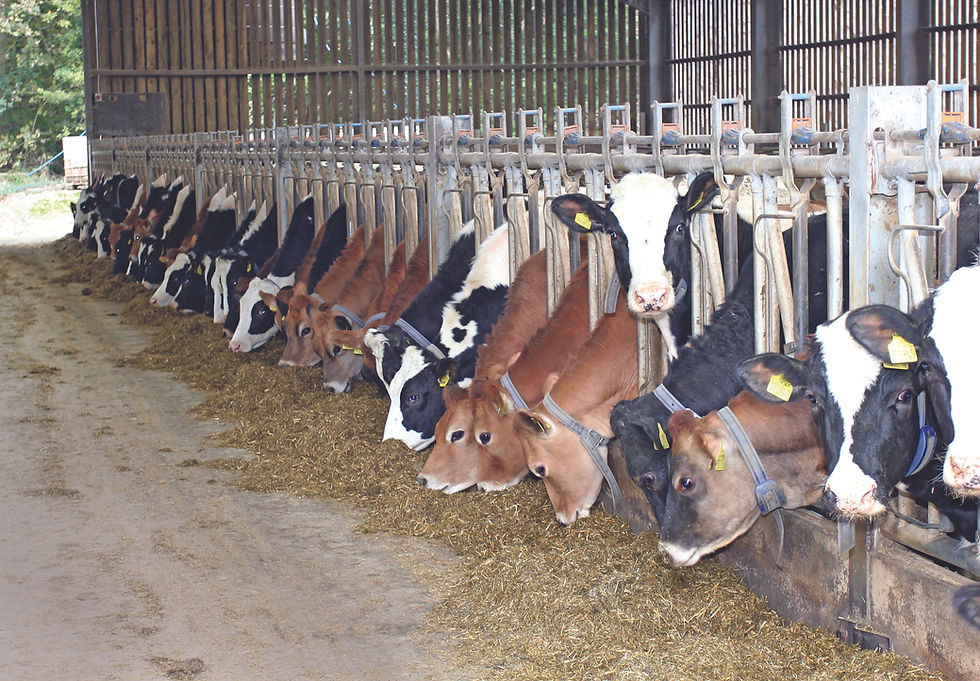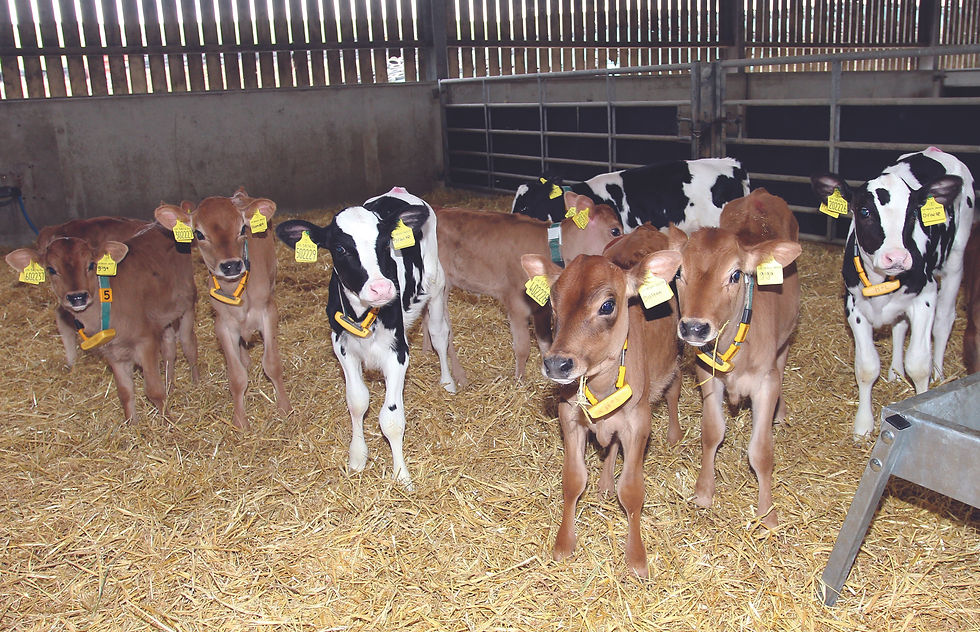A lot can happen in five years when you’ve overhauled your farming business, as a Scottish dairying family has discovered. And the result of their efforts is a more sustainable and efficient herd and unit.
TEXT KAREN WRIGHT

At a time when many producers who’ve clocked up 40 years at the helm of a dairy business might be taking things a bit easier, Allan and Janice Campbell found themselves ‘in the thick of it’. Together with son Robin, the youngest of their four children, during the past five years they have introduced a new breed, moved farms, and completed a series of developments to future-proof the business. Now with 240-hectares at Gatehouse of Fleet, in Kirkcudbrightshire on the west coast of southern Scotland, they’re running a closed herd of 420 Holsteins, 80 Jerseys, and 350 head of youngstock.
“Looking back, it’s been a busy five or so years, with changes we didn’t anticipate,” says Allan, who admits that many of the changes were spurred on, if not initiated, by Robin.
Returning to the business in 2013 after a spell in New Zealand, Robin has seized opportunities to learn about new technology and management ideas, and think how they might benefit their own business. Joining discussion groups, including the ASDA Arla Pathfinder initiative for next-generation producers, has been a big part of his learning.
The first major change came in 2016 when the Campbell’s introduced 60 in-calf Jersey cows from Denmark to boost milk quality.
Milk quality
“We’ve been long-time suppliers to Arla, and we were seeing the milk contract swing more in favour of milk quality,” says Allan. “Introducing Jerseys boosted fat and protein quickly, but we also put more emphasis on milk quality in our Holstein breeding and feeding. Both routes have contributed to improvements.”
The herd is milked three times a day and the Holsteins and Jerseys are recorded separately with NMR. Such hasbeen the improvement in the Holsteins that they now ranked fourth for solids in the milk-recording company’s production ranking for Scotland for the year ending September 2021. The Campbells also made the final three in this year’s AgriScot dairy farm of the year competition. Average combined yield, for Holsteins and Jerseys, has increased during the past 12 months with milk sold off the farm for the year to March 2022 at 11,277kg at 4.58% fat and 3.40% protein.
Allan admits they are Holstein producers first and foremost. “The Jerseys have helped milk quality, and they are ideal for our smaller cubicles, but Holsteins will remain the herd’s core breed.” He believes there is plenty of scope for improvement within the breed, which they plan to develop further through genomic testing.
Genomic testing
The Campbells have fast-tracked their introduction of genomic testing by starting with maiden heifers in summer 2022. Their first results – which showed the top 10% of heifers had the potential to give 500kg more milk, 0.05% more fat and 0.03% more protein in a lactation than the bottom 10% in the group – were enough to encourage them to test all younger heifers. “Results also showed that the top 10% of heifers had a 2% higher pregnancy rate and the potential to live six months longer than the bottom 10%,” adds Robin. “We’re using this to select the best 80% of the group to breed replacements from, and we can expect our breeding decisions to become more accurate when more of the herd is genomically tested.”

Tomorrow's milkers: genomic testing is supporting breeding decisions
Cow data is the reference point for all management decisions on the unit. The family uses Alta Blue Link for evaluating how many replacements are required and best use of sexed semen and beef sires. And their recent investment in Alta Cow Watch heat-detection and rumination collars has helped to push submission rates up to 82% and pregnancy rates to 28.5% during the past three months in this all-year-round calving herd.
Milk records
The dairy management system UNIFORM Agri is central to herd management. Based on real-time milk records, as well as health and fertility information, it generates management reports and action lists. Herd vet, Will McCarthy from Galloway Vets, also has direct access to UNIFORM for monitoring and advising. This has been key to improving herd health and tackling any problems, as well as supporting the herd’s move to using selective dry cow therapy, which has progressed to 89% of cows receiving no antibiotics at drying off.
Somatic cell counts are a respectable 86,000cells/ ml, and mastitis cases are running at 21 per 100 cows during the past six months. “We’ve tackled this by culturing milk samples to identify the mastitis-causing bacteria, and made changes to our milking techniques,” says Robin.
Likewise, Johne’s disease has been monitored through the HerdWise quarterly milk-sample screening and levels of infected cows are now less than 1%. “Keeping and managing healthy cows comes first,” adds Allan. “And our committed team has to take the praise for this. Four of the team are involved in milking, plus three part-time employees, and we’re supported by two more full-time staff. We have a good team and work together well.”
When the Campbells were given an opportunity to privately purchase a larger dairy unit 35 miles west of their original home near Dumfries it seemed an obvious jump in 2017.
“Luckily we could move the cows straight onto the new unit and continue business as usual. We were also fortunate to ‘inherit’ an eight-year-old 20:40 herringbone parlour.”
Building investment
Since then they’ve added two new silage pits and slurry storage, and this autumn they began using a new 145-cow cubicle building for fresh cows that offers more space and better accommodation to help take herd health and performance to the next level. Milking cows are run in four groups: fresh cows, pregnant cows, Jerseys, and first-lactation heifers. Average age at first calving is 23 months, so there are advantages in keeping these animals in their own group.

New housing: a 145-cow cubicle shed offers fresh cows more space and better accommodation
All milking cows are fed ration, which is based on grass silage. “Grass is king here,” adds Allan. “We’re in a good part of the world for growing it, and we aim to cut about 200 hectares each year on a multi-cut system. We cut the grass every month, starting in May.”
They aim to grow as much good-quality grass as possible, looking for an average ME above 11.5MJ/kgDM. Slurry use is also maximised. “We’ve put in a new slurry lagoon so we can store it until spring. We’re not in an NVZ, but we can apply it through a dribble bar at the optimum time. And we’ve reduced bought-in fertiliser use too, which is important for our finances and carbon footprint.”
Grassland management
Two slurry applications are made before first-cut silage and again after each cut. “Little and often – that’s the best way for grass growth,” says Allan. Approximately 20% of grass is reseeded each year, predominantly with intermediate ryegrass mixtures to balance yield and quality. Fluctuations in forage quality are minimised by mixing silage cuts to help maintain a consistent ration throughout the year. Ground maize, rape meal, caustic wheat, soya hulls and Trafford Gold are added to the ration to provide a 16.5% crude protein diet. The rumen buffer Equaliseris included in the diet.
Consulting’s Joss Fawcett walks the cows and youngstock on his monthly visits and, based on this and their performance, he formulates rations and advises on any changes required.
A semi-compact feeding system is used – an idea Robin picked up from a visit to Denmark. “We soak the premix of straights in water and whey overnight to reduce sorting by the cows,” he explains.
“We are aiming to increase yields from forage and also increase milk solids from the current average of 2.85kg per cow per day to more than 3kg. “We’re also focused on minimising our carbon footprint. Our latest result was 1.04 CO2-e per kilogramme of energy-corrected milk. We will keep scrutinising each area of the business and making improvements. We have plenty to keep us busy for the next five years.”
Owners: Campbell family
Herd size: 420 Holsteins, 80 Jerseys and 350-head of youngstock
Milk yield: 11,277kg, at 4.58% fat and 3.40% protein
SCC: 86,000 cells/ml
Johne's status: less than 1% J5



Comments